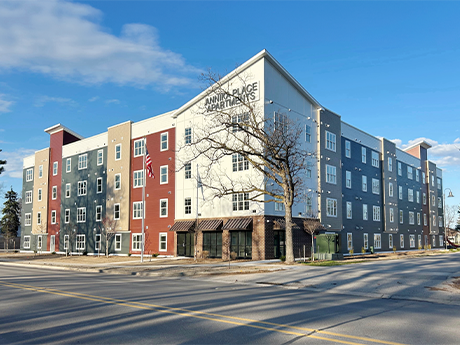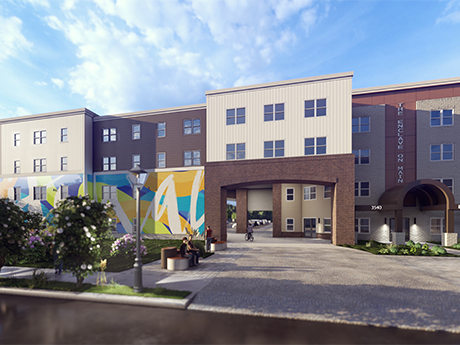— By Lynn Peisner —
Developers and owners are optimistic a slowdown in construction over the next two years will help boost occupancies and rents by cutting into the market-rate supply overhang. This may be good news for owners of existing assets, but it’s less than ideal for those who make a living in the construction business. Or so it would seem.
Most construction leaders are unfazed by an impending drought in new development. Some firms say they will rely on other sectors of commercial building to sustain them through the lull in apartment projects. Overall, the consensus among builders is that multifamily remains a secure line of business due to the high cost of owning a single-family home and a shortage of affordable housing.
Construction Companies Adapt
The National Association of Home Builders (NAHB) expects multifamily starts this year to total 342,000, down 28 percent from 2023. The recent peak was in 2022 when construction starts totaled 547,000.
In its U.S. Real Estate Market Outlook 2024, CBRE concluded that this decline in construction starts means that new deliveries annually will be reduced to less than half the current level by 2026.
“The pace of multifamily construction starts has slowed this year and will continue to be lower than average through 2025,” says Kinjal Patel, president of McHugh Construction. Patel was recently appointed president of the Chicago-based company in May. “However, by early 2026, we predict multifamily construction starts will be back to their long-term average.”
Alp Kirmizioglu, executive managing director of construction at Atlanta-based RangeWater Real Estate, is equally confident that the slowdown in construction starts is nothing to worry about.
“We are very bullish about the long-term outlook of the multifamily business,” says Kirmizioglu. “There’s still a meaningful shortage in units when compared with number of households. We view the current challenges, including high interest rates and a large wave of supply, as episodic, not structural.”
RangeWater, which manages nearly 91,500 apartment units nationally and is ranked as the 14th largest manager in the United States by the National Multifamily Housing Council, also develops properties.
The company launched an in-house construction division in 2022 and currently has three multifamily projects under construction in the Southeast.
Windy City Stands Out
Some companies will feel the hit of the apartment construction dry spell less acutely than others due to unique supply-demand metrics in their primary markets.
Chicago-based McHugh is actively building multifamily projects outside the Midwest, but most of the company’s projects are in metro Chicago, which avoided the overbuilding that occurred elsewhere, says Patel. Metro Chicago is supply-constrained, and new deliveries decreased by 7,000 units between 2020 and 2023, according to Marcus & Millichap.
This resulted in average effective rent growth of approximately 5 percent between March 2023 and March 2024. In May, Yardi Matrix ranked Chicago sixth out of 10 markets for highest rent growth annually in the nation.
Patel says that a constrained supply indicates multifamily construction ought to increase in order to meet a growing housing demand.
“However, with multifamily starts in a temporary lull, we will focus on our sports and entertainment projects as well as other sectors such as healthcare, adaptive reuse, light industrial and data centers,” explains Patel.
“Also, to fill the affordable housing gap, we’re interested in the conversion of office or light industrial to market-rate housing with an affordability component, especially in Chicago’s central business district.”

Filling a Void
Affordable housing is also on the radar of Alberto Fernandez, CEO of Davie, Florida-based ANF Group. Founded in 1981, ANF is active in South Florida and currently has 14 multifamily projects under construction. The company specializes in garden-style affordable housing, mixed-use development and luxury multifamily developments.
“I predict that the multifamily sector will trend toward affordable deals as that need continues to increase,” he says. “I believe that affordable and workforce deals will increase in the near future because every municipality struggles with having enough units available for their residents as housing costs, including market-rate multifamily rents, remain high.”
Some cities and states are prioritizing funding of affordable housing in order to make this dream a reality. Several states offer their own tax credit programs that are separate from federal tax-credit equity.
The City of Atlanta, for example, approved a resolution in May that provides construction financing to complement the typical Low-Income Housing Tax Credit. The resolution includes a tax-exempt loan and a bond loan totaling $40.4 million along with several grants to fund three separate developments in the Southside, Westside and Downtown areas. A construction timeline for the three projects has not been disclosed. In total, the City of Atlanta last year provided $175 million for affordable housing initiatives.
Palm Beach County is another area where government boards are prioritizing affordable housing development. In November 2022, the county’s voters approved a $200 million bond referendum to create more affordable units.
While the impending pullback in apartment construction has most industry leaders thinking creatively about filling the void, others are maintaining business as usual.
Lance Paulick, senior vice president, construction, with Columbus, Ohio-based Woda Cooper Cos., says multifamily construction activity is as strong as ever.
“Despite high costs, our volume has increased. There are a number of factors contributing to our growth. For one, we are vertically integrated, which means we develop, build and manage our communities in-house. That helps us in planning and understanding costs before we start,” explains Paulick.
“We are grateful we’ve been able to develop strong partnerships with local and state organizations that provide necessary, creative financing tools to help develop communities.”
Woda Cooper, active in 17 states, was founded in 1990 and typically builds about 25 multifamily projects per year.
Wild Cards: Insurance, Construction Costs
National survey results from the 2024 Construction Outlook conducted by the Associated General Contractors of America (AGC) indicate that almost two-thirds of commercial projects scheduled to start in 2023 or 2024 have been postponed or canceled.
Rising costs for construction and insurance were the primary reason for delay or cancellation, with rising interest rates cited as the second most common reason not to proceed as planned. Some companies say traditional barriers to development, such as the high cost of materials, are in fact decreasing. It’s the choppy economy and insurance costs that are limiting new construction.
“Steep increases in insurance premiums and interest costs have added to the pro-forma challenges developers are facing,” explains David Summers, president of CF Evans Construction.
Founded in 1948, CF Evans is headquartered in Orangeburg, South Carolina, and is active in Georgia and the Carolinas. The company is currently constructing 17 projects comprising approximately 4,000 units.
Kirmizioglu explains that the ebb in new construction starts can be attributed to factors beyond the control of a contractor.
“Construction costs have been flat, if not down, the past 18 months. Soft costs, especially taxes, impact fees and insurance, are where we’ve seen meaningful increases during that time,” says Kirmizioglu.
“Taxes and impact fees are not within our control. There is not a lot we can do with insurance costs either, beyond creating a master program to generate some scale and bargaining power,” he adds.
The availability and cost of land is another hurdle developers have to clear before they can get a project off the ground.
“Sitework costs continue to rise,” says Summers. He explains that state and federal infrastructure projects are keeping site contractors out of private sector work, which keeps labor costs high.
Site work includes tasks related to preparing land for development, such as surveying, excavating and grading. “Land costs also continue to rise, and many preferred sites have already been developed. We see more sites today with challenging conditions such as low-bearing-capacity soils, steep grade changes and drainage issues. These conditions all drive costs higher,” says Summers.

Labor Still in Short Supply
The construction industry is well known for being woefully understaffed. In a survey of builders conducted by NAHB and published in February, 73 percent of respondents cited the cost and availability of labor among their most significant problems in 2023, and 71 percent expected this problem to continue in 2024.
According to the Associated Builders and Contractors (ABC), a national trade association, the construction industry will need to attract an estimated 501,000 additional workers on top of the normal pace of hiring in 2024 to meet the demand for labor. It should be noted that the projection model presumes that construction activity will slow.
The construction industry employs approximately 8 million people in the U.S., reports AGC. Some of the hardest positions to fill include carpenter, bricklayer, cement mason, mechanic and electrician, per an ABC workforce survey.
“Labor costs rose even before the pandemic due to shortages of skilled trades and tremendous demand,” says Paulick. “The pandemic made things even worse.”
Quarterly starts peaked at 147,026 new units in the second quarter of 2022, reports CBRE, which is the highest number since 2014. This building boom of the early and post-pandemic years put a strain on labor. “Most contractors added a substantial backlog of new
development projects when interest rates were low, and demand was high,” points out Summers. “Until that work is completed, the demand for labor will remain high, as will the cost of that labor.
Some contractors are proactively seeking partnerships with outside groups to help fill positions.
McHugh, for example, works with Chicago-based HIRE360, which helps job seekers train and apply for jobs in construction. “With so many people in construction-related jobs aging out of the workforce, our industry is facing a labor shortage. We actively sponsor programs such as HIRE360, which trains the next generation for the trades,” says Patel.
— This article originally appeared in the May/June issue of Midwest Multifamily & Affordable Housing Business.


